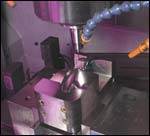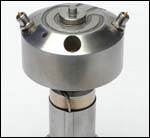Five-Axis Machining Is a Key Requirement for High-Precision Molds
Design and fabrication capabilities of advanced tool-cutting processes give toolmakers an edge in developing new business.
The aerospace and defense industries have a history of developing products that cross over into mainstream use. One notable example is the global positioning system, the ubiquitous directional aid. Both industries may be about to change the dynamic of moldmaking with another crossover technology—five-axis machining, a highly specialized capability that offers a number of benefits in mold design and fabrication.
Long a mainstay of part production in aerospace and defense, five-axis machining, a process suited for complex shapes, is becoming an important tool for moldmakers that compete in these industries. Since many of the process capabilities that qualify moldmakers for work in aerospace and defense are transferrable from other high-tech markets like automotive, medical and electronics, experts say it’s just a matter of time until five-axis CAD/CAM software and machining centers migrate from aerospace and defense to equally demanding consumer and industrial applications.
“Quite a range of industries would benefit from five-axis machining due to the complexity of their shapes,” says Vynce Paradise, Director of NX CAM Marketing for software supplier UGS (Plano, TX).
A versatile cutting capability is what makes five-axis machining so important in aerospace and defense work, and why it is almost mandatory for moldmakers. A five-axis machine can cut complicated shapes for parts like engine-turbine blades, which require toolpaths that follow undercuts and other nonlinear shapes. Even simple geometries like electronic boxes that need holes machined into them for wiring and other connections, can be finished quickly and with less labor—and sometimes better quality—by a cutter programmed to work on five sides without resetting the fixture. Since these capabilities can be applied to molds with undercuts and other complex shapes, the process has the potential to improve a moldmaker’s design and fabrication work while reducing machining time and the labor it requires.
Five-Axis Machining
Five-axis machining adds rotary motion in an A and a B axis to the linear motions of the X, Y and Z axes. The additional axes broaden the toolpaths of a cutter and the depth it goes without increasing tool length. The A axis usually pivots and the B axis is generally a swinging motion. The five axes combined cover virtually all cutting paths and angles and can be used to create dozens of machining configurations.
An important advantage of five-axis machining is the ability to cut deep features with a short cutting tool. A short tool is less prone to vibrations that could damage or shatter it during cutting, notes Hari Sridharan, Vice President of Engineering and Business Development at Cimatron Ltd. (Novi, MI). Short-tool cutting is achieved by using the A axis to tilt the cutter away from a wall so it can be guided deep into a cavity without the shank colliding with the vertical surface.
Short tools also maintain fast feedrates, a tradeoff with long cutting tools. Edwin Gasparraj, a Product Manager at UGS, says that tool deflection rises with cutter length and feedrates decline. “Anytime you increase tool length by 20 percent, deflection goes up by 50 percent and feedrates drop by 30 percent.” He says that a five-axis capability would permit a moldmaker to cut a 60-mm. cavity with a 30-mm. tool, a more stable and thus more efficient operation than with a longer version.
Another example of the benefit an A axis provides, Gasparraj says, is in machining shallow surfaces with a ball-and-mill. Many moldmakers use a fixed-axis ball-and-mill for this operation. But though the center point of the tool is in contact with the surface, it usually doesn’t produce a good finish because it doesn’t cut as effectively as the outer edges. Running the ball-and-mill on a tilted axis would move the center of the tool away from the surface, yielding a better cut and finish, he claims.
Trends
Despite these features, North American moldmakers have been slow to embrace five-axis machining. Use of the technology is more widespread in Europe and Japan. (Some leading software suppliers are, in fact, based in Europe.) But several trends have come together in recent years that make the process practical for broader applications in mainstream markets as well as in aerospace and defense.
- Software suppliers are fine-tuning programs to improve their use by moldmakers; some are also upgrading conventional three-axis programs with modules that add A and B axes.
- Equipment suppliers have developed relatively low-cost machining centers that are better engineered for the needs of moldmakers.
- Mold shops are increasingly seeking expertise in high-value areas to differentiate themselves from rivals and to offset the price advantage of offshore competition.
Offshore Outsourcing
This last point is particularly important, especially when dealing with Tier One suppliers and prime contractors. “The simpler the job, the more it becomes a labor-based situation,” says Alan Levine, Managing Director of Open Mind Technologies USA (Wellesley Hills, MA), a software supplier based in Budapest. “A lot of the mold shops that struggle with outsourcing should look at themselves and ask if they’re making the necessary investments to maintain their business edge, one of which would be a five-axis capability.”
Expertise in five-axis machining could be an important route to more business and closer relationships with customers. One corollary benefit for aerospace and defense, or any other major industry, experts say, is the ability a five-axis machine gives moldmakers to do more high-value work for prime contractors, many of which are under corporate mandates to reduce suppliers. If a company puts out five requests for quotes and the specs for three are too complex for a moldmaker, Levine, for one, says it’s likely that a program manager will look for a shop that can do all five parts rather than parcel out work to two or more.
And in the case of defense work, that mold shop doesn’t have to be in the U.S. “We can have subcontractors based offshore,” says Ben Hirschenfang, Deputy Program Director for JASSM (Joint Air-to-Surface Standoff Missile) at Lockheed Martin, one of largest military and aviation contractors in the world. “There are no requirements to do all our business in the U.S.”
Levine notes that the average cost of a five-axis machine, including the skilled operator who runs it, is about 30 to 50 percent more than for a three-axis unit. “But that machine has a premium in the market and will more than pay back the investment by giving the shop higher margins,” he adds.
Engineering and Advanced Mold Design Capabilities
When it comes to aerospace and defense work, high-value engineering and advanced mold design capabilities are givens for any company that wants in. And at present, both industries offer a lot of potential for business.
Civilian aerospace suppliers are experiencing a cyclical upturn from air-traffic growth of 5 percent/yr., much of it driven by demand for planes from developing nations in Asia and elsewhere. The upturn is expected to continue for the foreseeable future.
Defense spending has grown to more than $400 billion in the U.S., though programs are always at risk of being trimmed or cut. Nevertheless, while part volumes in both industries, especially defense, pale in comparison to consumer markets like packaging and automotive, programs tend to run for years and can provide steady sales and revenue. “A high-production missile will require several hundred parts a month,” according to Hirschenfang, “but a typical program lasts eight to 10 years.”
Like big consumer markets, aerospace and defense are price-sensitive. Moldmakers who know how to remove cost from their processes, though, can count on decent margins.
Materials
The inherent weight reduction and part-consolidation features of molded thermoplastics, thermosets and of composites make them ideal for use in many components, including load-bearing assemblies. Defense contractors and, increasingly, civilian aircraft builders are breaking ground in the use of advanced composites for structural applications. Examples include fighter planes like Lockheed Martin’s F-22 Raptor, which has a carbon fiber-reinforced epoxy body; Boeing’s 787 Dreamliner, a passenger jet with body and wings made of advanced composites; and the U.S. Navy’s DDG 1000 Class destroyers, being built by Northrop Grumman and General Dynamics, that feature a composite deckhouse to reduce weight, minimize radar signature and accommodate the ship’s electronics-rich network.
Not all applications are so advanced. Pyramid Mold & Tool (Rancho Cucamonga, CA) is probably more representative of the moldmakers doing business in these markets. Steve Hoare, President, says Pyramid builds injection molds and makes connectors out of polyimide and glass-filled polyamide for aerospace applications. A key strategy for Pyramid, Hoare says, is taking as much labor out of building molds as possible.
The tight tolerances and repeatability of molded parts, combined with the experience most mold shops have in meeting international quality standards, fit well with the demands of work in these areas. Good molds yield repeatable parts, says Hirschenfang, and consistent quality is critical to the performance of the products Lockheed Martin and other prime contractors supply.
Five-Axis Software
Leading examples of five-axis software include NX CAM from UGS. Like many programs it’s a product suite with elements such as product design, mold design and machining. The fact that all three are integrated within the same software is important, Paradise says, because the data maintain their integrity as they travel through production stages and eliminate the potential for error. Recent enhancements include an automatic function whereby the software tilts a mold to vertically machine a cavity wall without colliding with other geometries on the surface, and a program upgrade that permits three-axis users to acquire five-axis capability.
CimatronE NC is a program developed for maximum design and machining flexibility. Sridharan says that unlike some five-axis software that is for specific applications like turbine blades or inlets, Cimatron’s program can be used to design and machine virtually any type of product. Features include a full set of surface creation and editing tools, collision-avoidance functions that generate smooth tool motions and advanced simulation modules. One of the simulation features, “knowledge of remaining stock,” automatically keeps tabs on how much metal has been cut and how much remains to be machined. Sridharan says this promotes process efficiency and reduces machining time.
Open Mind Technologies’ main product for five-axis machining is hyperMILL, which Levine describes as a highly modular software package with as many as 40 machining strategies. The latest version is designed to permit automated operations of different functions for ease of operation and repeatability. The software can standardize recurring and similar geometries to automatically program repeat steps. Collision-avoidance algorithms are said to provide balanced machine movement and assure smooth toolpaths. Corners of cavities with sharp edges can reportedly be machined with a high degree of precision.
The latest versions of PowerMILL 7 software from Delcam (Windsor, ON) has a number of five-axis strategies for roughing operations that were added to match those previously available for finishing. Functions include machining to or from a point, orientation through a line or curve and programming using a reference surface. The software is said to have improved calculation times, better point distribution and simpler data-management functions than the prior version. Delcam claims that when necessary the PowerMILL software generates five-axis equivalents of three-axis toolpaths. This is a useful function where a job is mostly done with three-axis machining, but five-axis capability is required for select functions like avoiding obstacles. The company cites numerous examples where the use of PowerMILL five-axis software has led to substantial reductions in machining time (see Investments in Five-Axis Machining and Software Yield Big Payback sidebar above).
Before machining takes place, molds and products need to be designed and evaluated. SolidWorks Corp. (Concord, MA) offers programs that optimize the design process for critical applications like aerospace and defense, and can link with five-axis machining systems. Suchit Jain, Vice President of Analysis Products, says features of the software include MoldflowXpress from Moldflow Corp. (Framingham, MA), which creates a 3-D model of an injection molded part and assesses its moldability based on various engineering and process criteria. SolidWorks’ eDrawings collaboration program permits e-mailing of 2-D drawings and 3-D models to customers for input and modification. Engineers can tap into COSMOSWorks Designer from Cosmos (Los Angeles, CA) to identify potential part weaknesses that could lead to product failure, and use COSMOSExpress to determine optimum pressures and injection points across a mold for process uniformity.
In a related area, Pinion Software Inc.(Austin, TX) is touting Pinion Desktop Packager as a secure format for sending, receiving and reviewing confidential part-design files. Since moldmakers will almost always be part of a product-development chain of Second Tier subcontractors when working in aerospace and defense, the ability to securely review design plans is critical, especially since a shop could be exchanging plans with another contractor across the country or halfway around the world.
Pinion’s software, which works with desktop PCs and doesn’t require servers or an IT infrastructure, permits senders to apply a range of “permissions” to files they transmit, says Mike Staley, Marketing Manager. These permit selective degrees of access to the files. Permissions include passwords for authorized users; the ability to open files on certain computers; time-sensitive viewing windows; blocking the ability to forward files; varying levels of access to the files; and “shred-after” dates that destroy the data. To open files, recipients download a Pinion Receiver for free from the company’s web site. Much like the widely used Adobe Reader, this stays on a desktop and can be used to access future files.
Five-Axis Machining Equipment
Meanwhile, producers of machining equipment are promoting five-axis models designed for moldmaking. Examples include Mazak Corp. (Florence, KY), which supplies the Variaxis 630 machining center. Engineered to achieve tolerances of 0.0004 in., the unit has 24.8 in. of travel in the X axis, 30 in. of travel in the Y axis and 20 in. of travel in the Z axis. The A axis achieves a tilt range of +30 to -120 degrees, and the C axis offers 360-degree rotation and contouring capability. The model has a flexible pallet-handling system that maximizes cutting productivity. Pallet tables measure 19.7 by 25 in. The unit comes with a 12,000-rpm spindle and an optional 24,000-rpm version. The rapid traverse rate is 1969 ipm.
Mikron U.S. (Lincolnshire, IL) offers the HPM 1850U. Designed for workpieces weighing up to 4 tons, the machining center is said to provide accurate roughing and finishing, stable operation and user-friendly access and controls. Spindle speeds of 15,000 or 24,000 rpm are available, and the magazine holds 200 tools.
Summary
Aerospace and defense work can be an attractive, reliable and profitable source of business for moldmakers. Like all high-tech industries that place a premium on innovations in design and engineering, they require a willingness from suppliers to acquire the tools necessary to maintain leading-edge capabilities. Five-axis CAD/CAM software and machining centers give moldmakers a clear advantage in these markets, and will doubtless shape their competitiveness and value to end-users in other areas. As Paradise of UGS notes: “It’s the latest technology in moldmaking.”
Related Content
Solving Mold Alignment Problems with the Right Alignment Lock
Correct alignment lock selection can reduce maintenance costs and molding downtime, as well as increase part quality over the mold’s entire life.
Read MoreAdvantages and Disadvantages of Copper and Graphite Electrodes
Both copper and graphite provide approximately the same end result, so it is important for a shop to consider the advantages and disadvantages of each material in order to discover what would work best in their shop floor environment.
Read MoreForces and Calculations Are Key to Sizing Core Pull Hydraulic Cylinders
To select the correct cylinder, consider both set and pull stroke positions and then calculate forces.
Read MoreMaintaining a Wire EDM Machine
To achieve the ultimate capability and level of productivity from your wire EDM on a consistent, repeatable and reliable basis, regular maintenance is a required task.
Read MoreRead Next
It’s Gut-Check Time for Tool Builders
It’s time to adapt or die as business evolution dictates development of new business and manufacturing approaches.
Read MoreMold Builders Carve Lean Niche
Commodity-oriented consumer manufacturing left North America, but mold industry survivors are finding strong growth in technical market sectors.
Read MoreMedical: The Right Rx for American Tool Builders
When technology, quality and speed step to the fore in the medical world, so does the North American mold and die industry with some innovative products and processes.
Read More
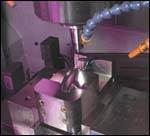

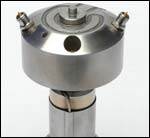
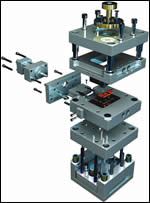
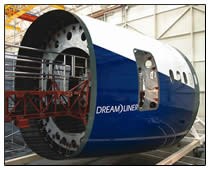

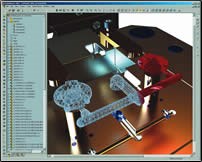
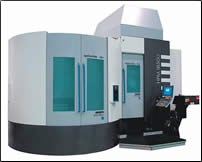
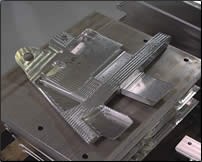
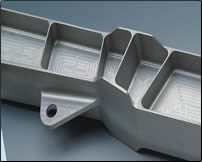










.jpg;maxWidth=300;quality=90)











